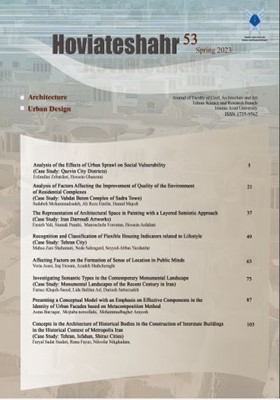The Representation of Architectural Space in Painting with a Layered Semiotic Approach (Case Study: Iran Darroudi artworks)
Subject Areas : architecture
Ensieh Vali
1
![]() ,
Siamak Panahi
2
,
Siamak Panahi
2
![]() ,
Manouchehr Foroutan
3
,
Hossein Ardalani
4
,
Manouchehr Foroutan
3
,
Hossein Ardalani
4
1 - PhD. Candidate in Architecture, Department of Architecture, Karaj Branch, Islamic Azad University, Karaj City, Iran
2 - Assistant Professor, Department of Architecture, Abhar Branch, Islamic Azad University, Abhar, Iran
3 - Assistant Professor, Department of Architecture, Hamedan Branch, Islamic Azad University, Hamadan, Iran
4 - Assistant Professor, Department of Philosophy of Art, Hamedan Branch, Islamic Azad University, Hamadan, Iran
Keywords: Layered Semiotics, Iran Drroudi, architecture, space, Painting,
Abstract :
Interdisciplinary studies linking art, philosophy, and theories of contemporary semiotics have opened a new path and vision to art explorations. The significance of meaning in artworks caused other disciplines to appear in art studies. This transformation implied that meaning in artworks is not an objective and evident component, requiring interpretation and analysis. Meaning can be transferred between different artistic media. Studying the relationship between architecture and painting is considered an essential interdisciplinary field of research. Architectural space is a media manifesting as a painting in its interaction with the artist.These studies have raised a profound understanding of the artwork's meaning. In addition, providing a scientific knowledge of art has made them well known. Moreover, there is a need for interdisciplinary comprehension of art with social and human approaches. The present article aims to examine the role of architectural space in the creation of paintings with an emphasis on interdisciplinary studies. The main question is, "considering painting a text entailing semiotic codes, what semantic approaches to architectural space can affect it through profound exploration of the spatial layers, and how can a painting be read? ".The general justification of this article is to explain and describe the relationship between architecture and other types of art, especially painting.Although architectural structures and spaces are a combination of applied and functional approaches, they can be studied as artworks to yield an interactive synergy between their aesthetic and semantic layers concerning other subcategories of art, such as painting. Moreover, in the next step, the paper discusses the meaning layers of the space in artists' minds. When painting, the artist detaches from the real world, reaching a clearer understanding of the mind's reality through an experimental journey.This mental projection involves new manifestations of spatial visualization within the image.The article used a qualitative approach to research based on an interdisciplinary study of architecture and painting. In the first section, spatial codes are embedded in different layers according to the space approach; then, a theoretical framework is introduced based on layered semiotics to read the spatial implications of the case studied.Given the apparent representation of architectural space in Iran Darroudi's artworks, we have selected her paintings (Everlasting Marriage; Steadfastness; Stupor of the Plain and Thirst of Desert) and collected primary data using a library-survey method.The results showed that the architectural space, transformed into a system of meaningful places for the artist, can be manifested in the painting as spatial codes. The painter expresses her idea of the urban space in spatial signs in the form of isotopia, heterotopia, or utopia, which can be read in syntagmatic layers.In the textual and media layers, the physical reading of space is matched with the architectural typology method. In a principled correlation, spatial approaches are decoded in the code and text layer. Finally, spatial-phenomenological relations are identified from the painter's existential space in the intertextuality-coding layer. These may be read in textual, intertextuality, and coding layers, as well as semiotics, phenomenology, and typology.
_||_


